Technologies
Apple Watch Series 8 vs. SE: Which One Is Right for You?
The Series 8’s extra health-tracking features, faster charging and always-on display separate it from the SE.
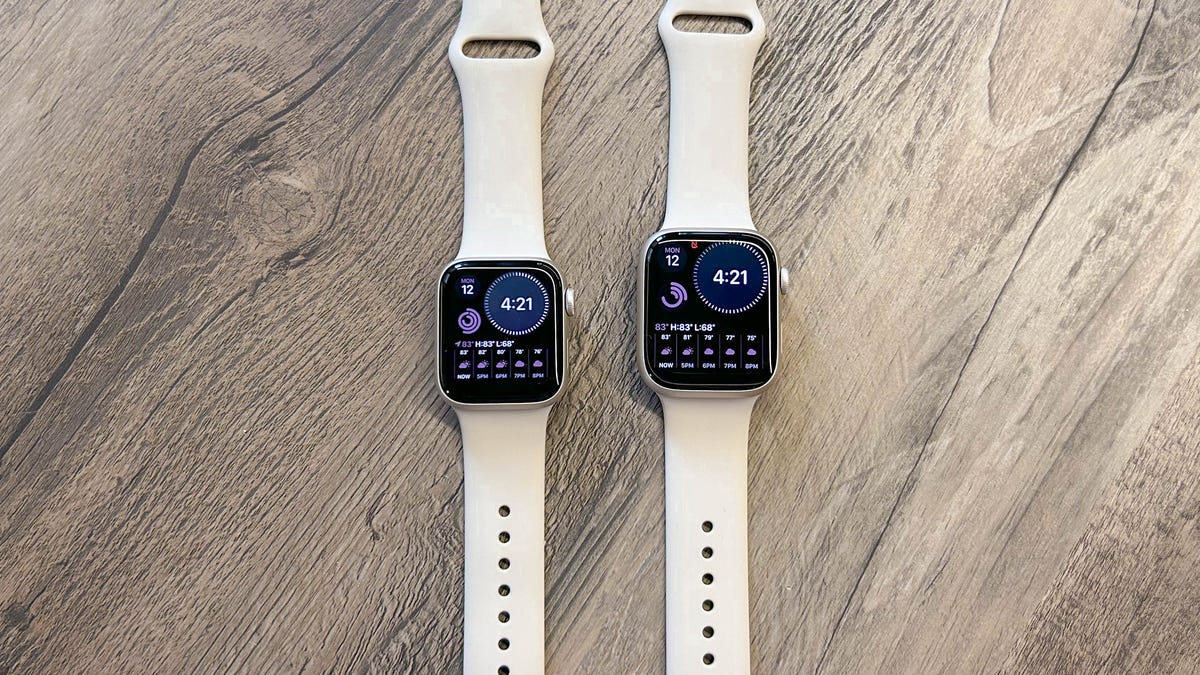
Deciding on a new Apple Watch can be challenging, especially if you’re choosing between the $399 Apple Watch Series 8 and the $249 Apple Watch SE.
Unless you’re an avid scuba diver or rock climber — or want to look like one — you’re probably not considering the $799 Apple Watch Ultra. The Series 8 and SE are both intended for everyday wearers that want to keep an eye on their health and fitness levels, but don’t need the Ultra’s larger screen, longer battery life and extra features tailored for the outdoors.
Both the Series 8 and SE run on Apple’s WatchOS 9 software, have the company’s newest chip and are among the first to detect car crashes. That’s in addition to the functionality Apple’s watches have offered for years, like the ability to track workouts, detect hard falls and mirror iPhone alerts.
Which one is right for you depends on what you want in a smartwatch. As someone who primarily uses my Apple Watch for logging exercise, viewing notifications and checking the time, there’s little that I missed when switching from the Series 8 to the SE after testing both.
The biggest reason to choose the Series 8 over the SE right now is its extra health-tracking smarts, such as its new wrist temperature measurements, blood oxygen saturation readings and the ability to take an electrocardiogram. The Apple Watch isn’t a medical device and shouldn’t be treated as such. But those who want more data on their cardiac and respiratory health to share with their doctors might find the Series 8 to be the better choice.
I think the Series 8’s main benefits will become more clear over the long term. Temperature sensing is still new, but I like the idea of being able to see how changes in my baseline temperature may correlate with how I’m feeling that day. The Series 8’s ultrawideband chip, which isn’t present in the SE, may also feel more valuable in a future where unlocking your car with your phone or watch is just as common as using Apple Pay at the checkout counter.
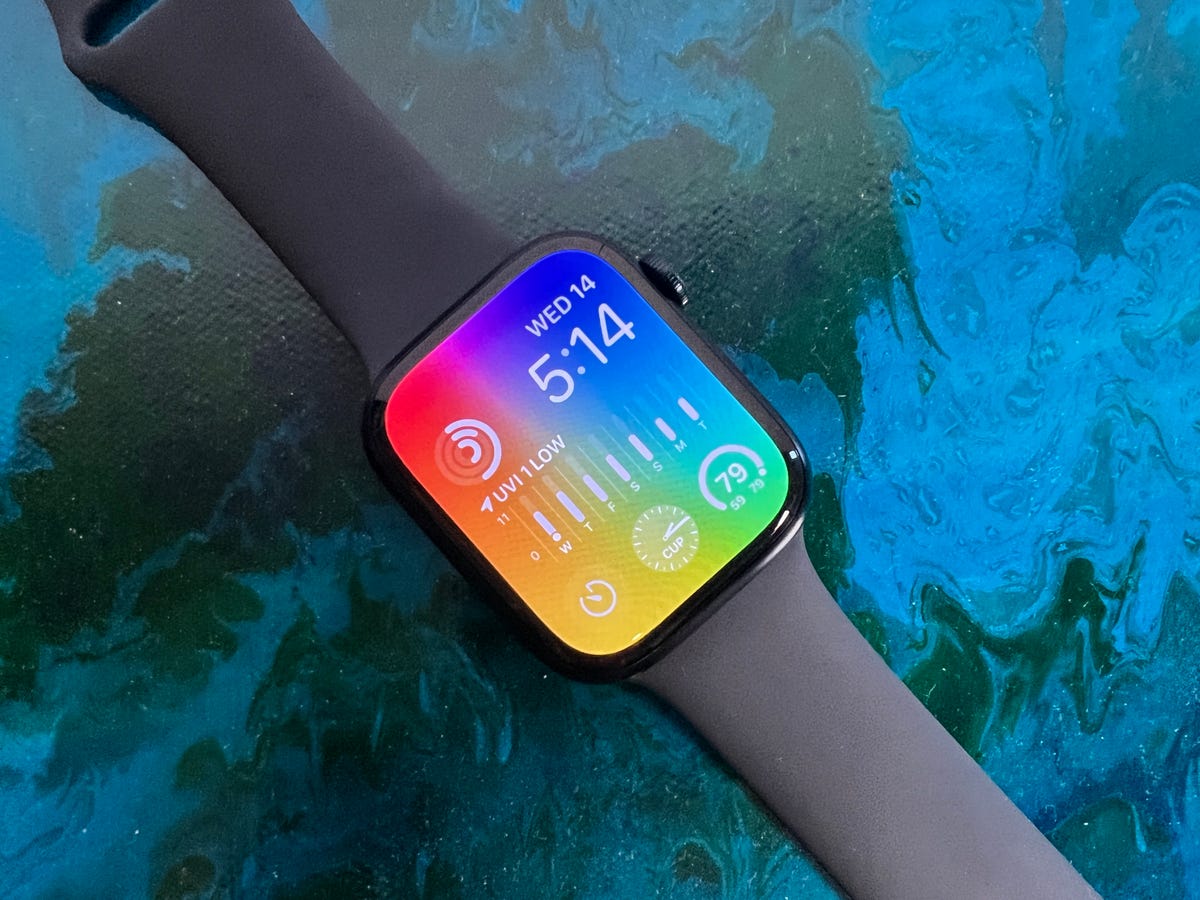
A larger screen with an always-on display
If you were to ask me what I’ve missed most about using the Apple Watch SE, it’s the always-on display found on the Series 8 and other flagship Apple Watches since 2019. Without an always-on display, the Apple Watch SE’s screen just turns into a black box on my wrist, which isn’t exactly the most attractive look.
When wearing the Series 8 (or the Series 5, 6 or 7), I can view my watch face anytime without having to raise my wrist or touch the watch. I don’t think the always-on display alone is worth paying an extra $150 if you don’t care about the other health extras that come with the Series 8. But I do wish the always-on display was standard across all Apple Watches at this point.
The Apple Watch Series 8 also has a larger display and comes in 41- and 45-millimeter case sizes, compared to the 40 or 44mm SE. Having a bigger display is nice, but the only thing I missed is the Series 8’s QWERTY keyboard for typing responses to text messages (the Series 7 has this too). On the SE, you can still scribble letters, dictate words or send canned responses, but I like the flexibility of being able to quickly type a couple of words. Those who prefer larger text sizes may also want to choose the Series 8 over the SE.
The Series 8 is also available in a pricier stainless steel finish, and the aluminum version comes in an additional Product Red color option not available on the SE.
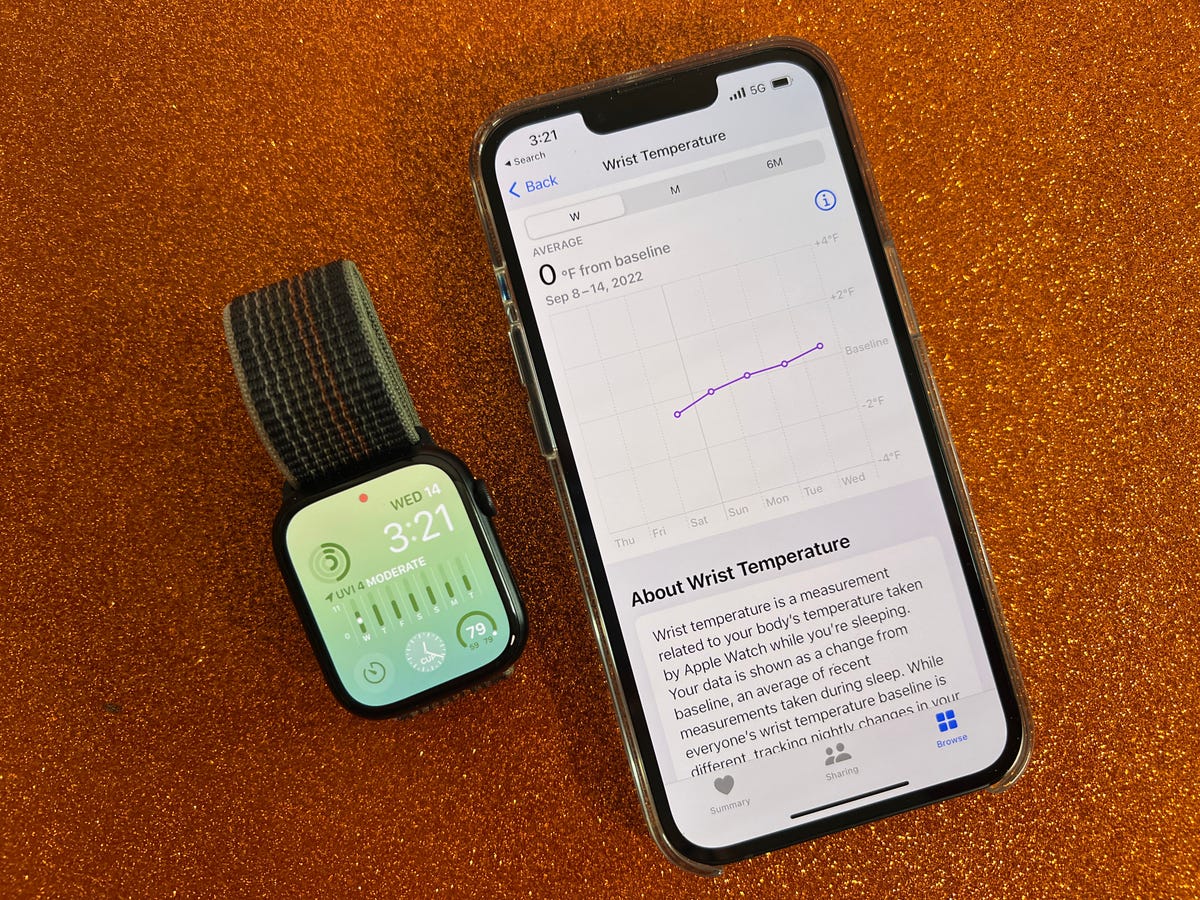
More health tracking
Apple’s flagship watches like the Series 8 have evolved into comprehensive health-tracking devices, with the ability to take an ECG from your wrist and monitor blood oxygen levels. The Series 8 and Ultra are the first to get temperature sensors, enabling them to check your wrist temperature overnight and show whether you’ve deviated from your baseline. It takes five nights to set up temperature sensing, since the watch needs enough time to establish your baseline wrist temperature.
Apple says nighttime wrist temperature can be an indicator of overall body temperature, and changes could possibly be caused by illness, jet lag or exercise. Since the Apple Watch doesn’t have a readiness score like Oura or Fitbit, I could see this information being useful for helping me decide whether my body needs extra rest.
I’m hoping Apple weaves wrist temperature readings into new features and insights in the future. Right now, you can see a chart showing how your nighttime temperature readings deviate from your baseline. But it generally seems like it’s up to you to interpret these readings.
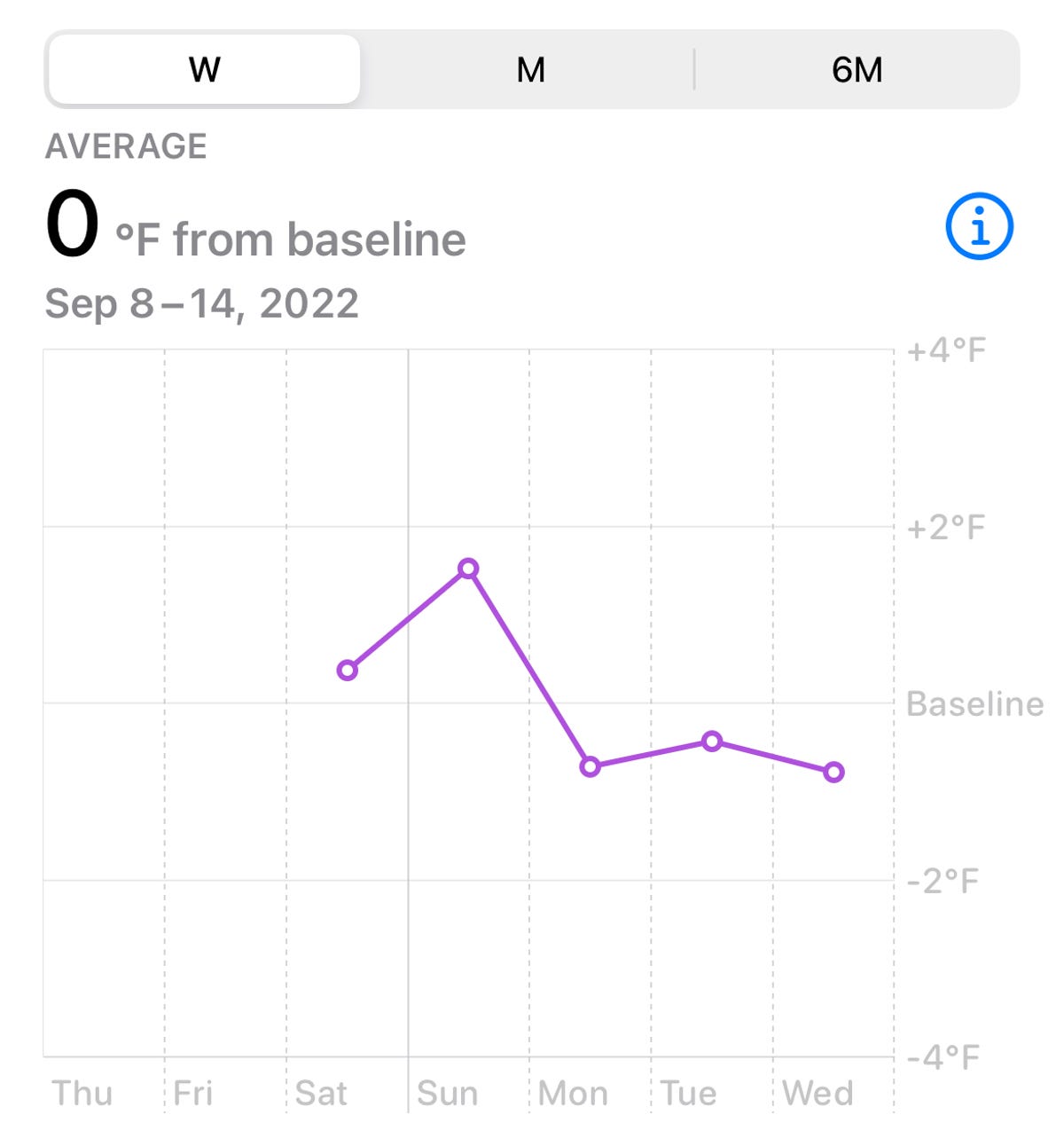
The Apple Watch isn’t a medical device and can’t alert you when you’re sick, so it can be hard to know how to use this data. That’s part of the reason why I never check my blood oxygen levels; it’s just another statistic that I’m not sure what to make of. I’ve been wearing the Apple Watch Series 8 consistently for a couple of weeks, but I’m still not sure what to do with this temperature data.
My nighttime wrist temperature is pretty close to my baseline most of the time, but it’s usually a fraction of a degree higher or lower. Sometimes my deviations are as high as 0.37 degrees Fahrenheit above my baseline or 0.55 degrees below the norm. I can’t connect the dots between those deviations and what may have happened to cause them. It’s also difficult to wear the Apple Watch Series 8 consistently overnight since I have to charge it during some evenings.
Still, having another data point like wrist temperature opens up some interesting opportunities for the future. I’m hoping Apple finds new ways to crunch all of these statistics together to enable new insights and actionable advice. Until then, nighttime wrist temperature is yet another metric you can potentially share with your doctor if you’re not feeling well, but it’s difficult to tell how useful it actually is.
For now, the biggest application for the Series 8’s temperature sensing will likely be fertility tracking. Apple says the Series 8 and Ultra can provide retrospective ovulation estimates and improved period tracking, potentially making the Series 8 a better choice for those who are interested in using it for family planning purposes. That information can be helpful because it provides users with data from their own bodies, rather than just making estimates based on the length of their cycle.
«But this actually gives you real life data because the time of ovulation can vary from person to person from month to month,» said Dr. Angela Bianco, MD, director of maternal fetal medicine at the Mount Sinai Health System. «Some people ovulate earlier in their cycles, others ovulate later in their cycles.»
Again, the Apple Watch isn’t a medical device and shouldn’t be treated as such. It also shouldn’t be used for contraception.
«I stress that women who are trying not to get pregnant should not use this because there can be errors in the data,» said Dr. Alexis Melnick, an OBGYN at NewYork-Presbyterian and assistant professor at Weill Cornell Medicine. «And you can have a cycle that is variable that may not follow the regular pattern.»
Apple says data stored in the health app — including female health statistics like ovulation estimates — is encrypted when your iPhone is locked with a passcode, Face ID or Touch ID. The same goes for data backed up to iCloud.
You’ll also want to make sure two-factor authentication is enabled for your iCloud account, which should be turned on by default. This ensures that health data is end-to-end encrypted, meaning Apple cannot read or access your data. To make sure two-factor authentication is on, open the Settings menu on your iPhone, tap your name and choose the Password & Security option.
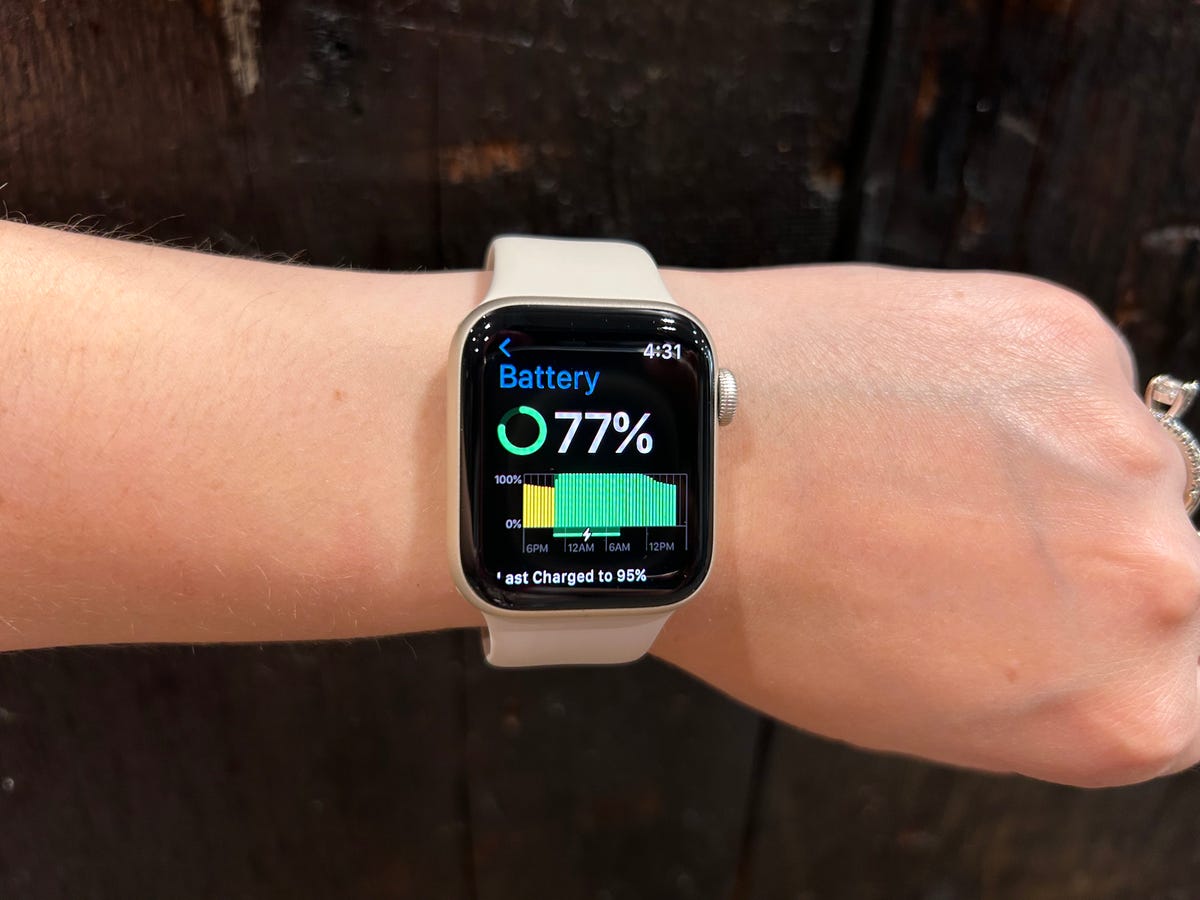
Other extras, like faster charging and ultrawideband
While the Series 8’s extra health sensors are the biggest reason to potentially choose it over the SE, there are a few other extras to consider. The Series 8 can charge more quickly than the SE, as it inherits the fast-charging capabilities of the Series 6 and 7. The Apple Watch Series 8 charged from 70% to 80% in 10 minutes, while the SE charged from 70% to 77% over the same time period. For each watch, I used the included charging cable and the same power adapter plugged into the same outlet. Both watches have Apple’s new low power mode, which dials back certain features like automatic workout detection to extend battery life.
The Series 8, like the Series 6 and 7, also have Apple’s U1 ultrawideband chip. Ultrawideband is a wireless protocol for proximity sensing that’s become common in new flagship phones and smartwatches. Ultrawideband is primarily used for finding misplaced items and gadgets using Apple’s Find My service, or for unlocking your car with more precision than Bluetooth.
If you have a car that’s compatible with ultrawideband, for example, you can unlock your vehicle automatically as you approach it with your Apple Watch. Ultrawideband is said to be more secure and precise than Bluetooth when functioning as a key, which you can read more about here. It’s a nice perk, but it’s likely not a necessity for everyone. At least not yet.
The bottom line
The Apple Watch Series 8 and SE have a lot in common when it comes to core features and functionality. They can both track workouts, show iPhone notifications, provide high and low heart rate notifications and detect irregular heart rhythms. They also both come with safety features like emergency SOS, fall detection and car crash detection, the latter of which is exclusive to Apple’s 2022 smartwatches. The new Compass app, which includes a new feature to help you retrace your steps, is also coming to both watches as well as the Series 7, Series 6 and first-generation SE.
If you like using Apple Pay or syncing your Apple Watch to the treadmill at your local gym through GymKit, you’ll do just fine with either the new SE or the Series 8. They both have the same processor, support low power mode and run on Apple’s new WatchOS 9 update.
The difference really comes down to health tracking. By choosing the SE, you’ll miss out on the Apple Watch’s ECG app, blood oxygen sensor and new temperature sensor. Whether those features are necessary depends on what you hope to get out of your smartwatch. Do you primarily want to track workouts, or are you looking for deeper health metrics to share with your doctor?
You’ll also get a few perks that make the Series 8 a better iPhone companion, such as a larger always-on display, faster charging and ultrawideband support. Of those features, I personally find the always-on display to be most useful.
Overall, the Series 8 seems poised to become more useful over time, especially after I’ve had more time to test the temperature sensor. Ultrawideband is another feature I’m expecting to become more useful in the long term as using mobile devices as digital keys starts to become more common. But for now, ultrawideband alone shouldn’t be a deciding factor; it’s more about the sum of how all of these parts come together.
The Series 8 is the right option for those who want more health-tracking features and are willing to pay a premium for it. The Apple Watch SE is the best choice for those who are upgrading from an older watch or are buying an Apple Watch for the first time and just want an Apple Watch that feels new and has all of the core features. But if you have a recent Apple Watch like the Series 5, you can probably hold off on upgrading entirely unless you really want Apple’s new health upgrades.
Apple Watch Series 8 vs. SE
| Apple Watch Series 8 | Apple Watch SE | |
|---|---|---|
| Starting price | $399 | $249 |
| Size | 41mm or 45mm | 40mm or 44mm |
| Finishes | Aluminum or stainless steel | Aluminum |
| Colors | Aluminum: Midnight, starlight, silver, Product Red; Stainless steel: Graphite, silver, gold | Midnight,starlight, silver |
| Software | WatchOS 9 | WatchOS 9 |
| Screen | 904 sq mm display area (41mm); 1,143 sq mm display area (45mm) | 759 sq mm display area (40mm); 977 sq mm display area (44mm) |
| Health sensors | Blood oxygen, electrical heart (ECG),third-gen optical heart, temperature | Second-gen optical heart |
| Health features | High and low heart rate notifications, irregular heart rate notifications, blood oxygen, nighttime wrist temperature deviations, cardio fitness level, cycle tracking, retrospective ovulation estimates, sleep tracking | High and low heart rate notifications, irregular heart rate notifications, cardio fitness level, cycle tracking, sleep tracking |
| Chip | Apple S8 SiP | Apple S8 SiP |
| Durability | IP6X dust resistant;water resistant up to 50m | Water resistant up to 50m |
| Safety | Emergency SOS, international emergency calling, crash detection, fall detection | Emergency SOS, international emergency calling, crash detection, fall detection |
| Battery | Up to 18 hours with fast charging, support for low power mode | Up to 18 hours, support for low power mode |
| Storage | 32GB | 32GB |
| Other features | GPS, optional cellular, Compass Backtrack, always on altimeter, Family Setup, speaker, microphone, activity and exercise tracking, Apple Pay, GymKit, ultrawideband support | GPS, optional cellular, Compass Backtrack, always on altimeter, Family Setup, speaker, microphone, activity and exercise tracking, Apple Pay, GymKit |
Technologies
Razer’s Wolverine V3 Pro 8K Controller Won’t Replace My Mouse and Keyboard, but Here’s Where It Shines
I applaud the absurdly high polling rate, six extra remappable buttons and TMR sticks, but let me tell you why I’m sticking with my keyboard and mouse for most games I play.

The Razer Wolverine V3 Pro 8K PC controller was not built for me, but admittedly, this has more to do with me as a gamer than the controller itself. I grew up playing the PlayStation 3 and PS4 consoles, cutting my teeth on slim, compact DualSense controllers. Over the past five years, I’ve gamed exclusively on my PC and have grown accustomed to the increased precision of a mouse and keyboard.
The Razer Wolverine V3 Pro 8K PC controller is the antithesis of a DualSense controller. It’s a chunky piece of hardware that might feel natural if you were raised on an Xbox and its bulky controllers, but it took me multiple gaming sessions to get acclimated to the sheer size of the Wolverine V3 and how it fit into my hands, especially since I don’t use a claw grip.
Size aside, this is a PC controller with every bell and whistle you can think of — and its price of $200 reflects that. The 8,000Hz polling rate ensures buttery smooth inputs with no lag, and tunnel magnetoresistance joysticks make every in-game movement feel fluid and calculated. Six extra remappable buttons help you up your game — they’re super handy for hero shooters like Marvel Rivals and hectic games like Battlefield 6. This is a premium product for gamers who are hoarding some serious hardware.
Its price is in line with other premium controllers. One of CNET’s best Xbox controllers is the Wolverine V3 Pro for Xbox, which also costs $200. Similar controllers like the Scuf Instinct Pro and Vitrix Pro BFG are in the same ballpark, pricewise, but the Wolverine V3 Pro 8K PC has a winning combination of competitive variables that make it feel exceptionally easy to use.
This controller is chock full of top-of-the-line technology and feels satisfying to use, but it needs to clear a high bar to feel truly worthwhile as a dedicated PC controller.
Chunky controller, satisfying feedback
When CNET’s Josh Goldman reviewed the Wolverine V3 Pro Xbox wireless controller, he called it «just about perfect.» If it isn’t broken, don’t fix it: Razer replicated many of its successes with the Wolverine V3 Pro PC controller.
The Wolverine V3 Pro 8K PC is the same size as the Wolverine V3 Pro Xbox controller, which is to say it’s a bit chunkier than a standard Xbox wireless controller, but it’s surprisingly much lighter than its Xbox cousin. It weighs just 220 grams, which is appreciably lighter than the Xbox version that weighs 304 grams. And while the Wolverine V3 Pro 8K PC is nowhere near as slim as a DualSense controller, it’s still much lighter than its Sony competitor — a stock DualSense controller weighs 280 grams.
Every button on this controller has a crisp, clean clickiness that scratches the same mental itch that a good mechanical keyboard might. Whether you’re gripping the trigger, pressing a button or squeezing one of the four remappable back paddles, you’ll hear incredibly satisfying auditory feedback that leaves no doubt that the controller is receiving your inputs. At one point, while I sat through a particularly long matchmaking queue, I found myself squeezing the triggers to entertain myself — the snappy pops were enough to keep me off TikTok.
The biggest difference between the V3 Pro Xbox and V3 Pro PC controllers is the variable polling rate — that dictates how often your controller is communicating with the computer. It’s like a refresh rate for your crosshair positioning.
The Wolverine V3 Pro Xbox just can’t compete here: That controller has a wired 1,000Hz polling rate for PC gameplay. The V3 Pro PC controller can be toggled for multiple polling rates, with an 8,000Hz maximum setting. This means the PC controller can report your input data eight times faster than the Xbox controller.
Every movement, turn and button press feels incredibly fluid. It’s safe to say that there’s no input lag with the Wolverine V3 PC controller, but I don’t think it matters too much for moment-to-moment first-person shooter gameplay. If you’re driving a car (or a tank) and you need to stop on a hairpin, you might appreciate Razer’s HyperPolling technology. If you’re not playing a tactical shooter like Counter-Strike or Rainbow Six: Siege, that 8,000Hz polling rate is overkill — if you’re a casual gamer crushing Call of Duty public lobbies with your pals, you’re probably not going to notice it in any of your firefights.
Better than a mouse and keyboard? That’s a little more complicated
I tested out the Wolverine V3 Pro 8K PC controller on Marvel Rivals, ARC Raiders and Battlefield 6 (my current first-person shooter obsession). It’s an extremely solid choice for at least two of these games, and I likely won’t be using my DualSense controller anytime soon.
I had a great time firing magic bolts in Marvel Rivals and rolling tanks through the streets of Cairo in Battlefield 6, but this is a controller that was supposedly designed for high-level shooter gameplay. I’m saddened to report that, when it comes to dominating a first-person shooter match or competing to survive in an extraction shooter, I’d much rather stick to a mouse and keyboard.
In close-range battles, I didn’t feel like the Wolverine controller particularly helped me gain an advantage over my opponents. Mouse-and-keyboard players were often able to lock onto me quicker, even with a high look sensitivity and built-in aim assist. And I felt outmaneuvered and outgunned by mouse-and-keyboard players in the fastest-paced fights. But the controller’s precision TMR thumbsticks made it easy to quickly lock my crosshairs onto enemies and mow them down from afar with light machine guns or sniper rifles in long-range battles.
I also find it useful for games like Battlefield that have a lot of buttons to micromanage during moment-to-moment gameplay. If you want to swap your fire mode from automatic to single-fire, mount your weapon’s bipod against a flat surface or pull out an invaluable class gadget, you’ll be reaching across your keyboard to do so. The six remappable buttons on the Wolverine V3 Pro 8K PC are great for these situations; I loved that I could tap fire my hulking light machine gun by gripping one of the controller’s back paddles.
The controller really shone for vehicle combat, though. I found myself gravitating toward my mouse and keyboard for infantry gunplay, but anytime I’d jump into a tank, I’d reach across my desk and grab the Wolverine again. Having pressure-sensitive triggers helps with any in-game driving: A slight squeeze lets me cautiously move forward, scanning for enemy mines, while fully pulling the trigger down helps me speed out of dangerous situations. Rebinding automatic repair jobs and weapon switches to the back paddles also helped me focus more on in-game combat, which helped me keep my armored vehicles in the fight for longer. With my DualSense controller, I’d have to awkwardly fumble with the D-Pad to activate my vehicle abilities. The Wolverine controller is the definitive way for a Battlefield tank enthusiast to play.
Outside of standard first-person shooter gameplay, I also found the Wolverine V3 PC controller to be handy for hero shooters — with some caveats. When I play Marvel Rivals, I mainly play tanks that require an extensive amount of ability usage but very little aim. Characters like Doctor Strange thrive when you can quickly string inputs together, and rebinding the controls to the Wolverine’s back paddles is great for that.
On the other hand, speedy divers that need to jump in and out of the enemy team’s backline and aim-intensive snipers feel tougher to play with the Wolverine controls, and I’d swap back to my mouse and keyboard whenever I wanted to switch off tank characters and fulfill another role for my team.
One game I don’t recommend the Wolverine V3 Pro PC for is ARC Raiders. While the remappable buttons make it easy to reach for healing items and grenades, losing out on the precision aim of a mouse and keyboard just isn’t worth it in a game where one death can set your progress back by several real-life hours. The controller lets me hold my own against killer ARC robots, but once real players join the mix, I’d rather use my tried-and-true PC hardware setup.
That’s not to say that the Wolverine controller is terrible for a tactical third-person shooter: The back paddles are a great way to quickly access any healing items, grenades and other consumables you’re carrying, which could be the difference between life and death. But when I have teammates depending on me to help them escape with their hard-earned loot, I just don’t trust the Wolverine controller to help me aim better than I can with my trusty mouse and keyboard.
For playing first-person shooters like Call of Duty or Apex Legends at breakneck speeds, the Wolverine V3 Pro 8K PC likely won’t replace your mouse and keyboard. But if your ideal competitive game centers on slower gunplay and long-range firefights, this is the most precise controller I’ve ever laid hands on (and you’ll receive a healthy heaping of help from aim assist to boot).
For the games I like to play, the Wolverine V3 Pro PC controller hasn’t become my primary gaming peripheral. Instead, it’s become a great situational swapout that complements my mouse and keyboard. As much as I like keeping it on deck for a long gaming session, $200 is a high price for a part-time controller.
Technologies
The Most Exciting Video Game Rumors and Leaks Ahead of 2026
Technologies
Today’s NYT Mini Crossword Answers for Wednesday, Dec. 17
Here are the answers for The New York Times Mini Crossword for Dec. 17.
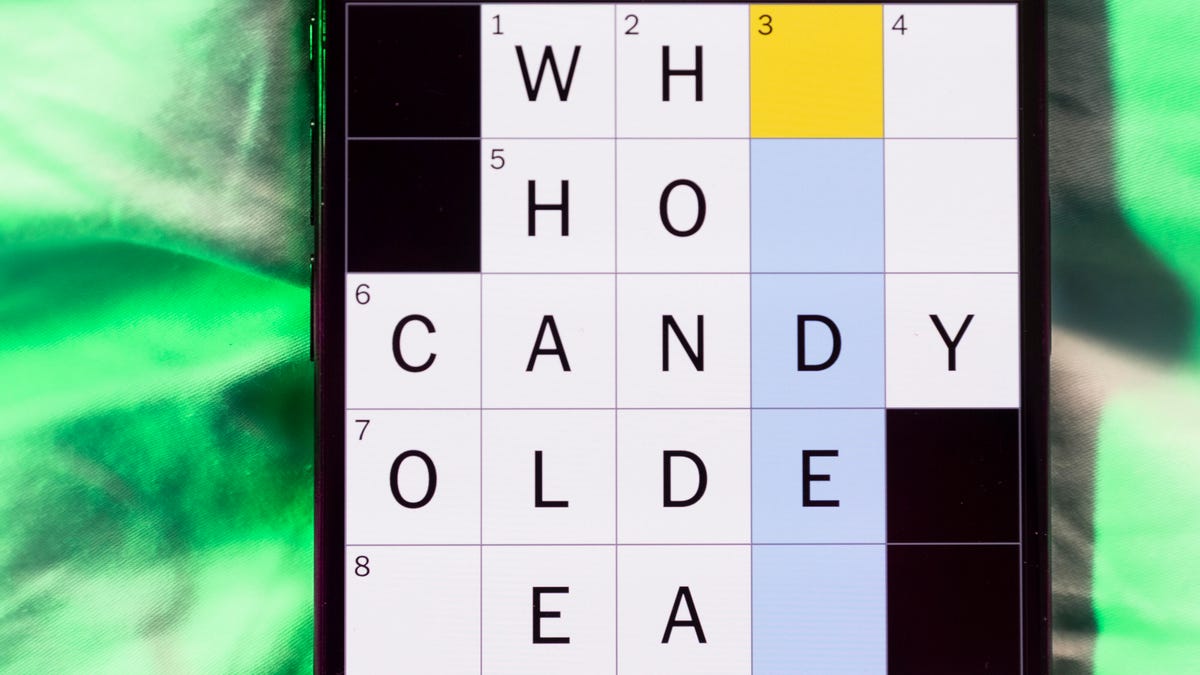
Looking for the most recent Mini Crossword answer? Click here for today’s Mini Crossword hints, as well as our daily answers and hints for The New York Times Wordle, Strands, Connections and Connections: Sports Edition puzzles.
Need some help with today’s Mini Crossword? Read on. And if you could use some hints and guidance for daily solving, check out our Mini Crossword tips.
If you’re looking for today’s Wordle, Connections, Connections: Sports Edition and Strands answers, you can visit CNET’s NYT puzzle hints page.
Read more: Tips and Tricks for Solving The New York Times Mini Crossword
Let’s get to those Mini Crossword clues and answers.
Mini across clues and answers
1A clue: Nod (off)
Answer: DOZE
5A clue: Naval submarine in W.W. II
Answer: UBOAT
7A clue: Tricky thing to do on a busy highway
Answer: MERGE
8A clue: Heat-resistant glassware for cooking
Answer: PYREX
9A clue: Put into groups
Answer: SORT
Mini down clues and answers
1D clue: Break up with
Answer: DUMP
2D clue: Falls in line, so to speak
Answer: OBEYS
3D clue: Legendary vigilante who cuts a «Z» with his sword
Answer: ZORRO
4D clue: Rarin’ to go
Answer: EAGER
6D clue: Common reminder for an upcoming appointment
Answer: TEXT
Don’t miss any of our unbiased tech content and lab-based reviews. Add CNET as a preferred Google source.
-

 Technologies3 года ago
Technologies3 года agoTech Companies Need to Be Held Accountable for Security, Experts Say
-

 Technologies3 года ago
Technologies3 года agoBest Handheld Game Console in 2023
-

 Technologies3 года ago
Technologies3 года agoTighten Up Your VR Game With the Best Head Straps for Quest 2
-

 Technologies4 года ago
Technologies4 года agoBlack Friday 2021: The best deals on TVs, headphones, kitchenware, and more
-

 Technologies4 года ago
Technologies4 года agoVerum, Wickr and Threema: next generation secured messengers
-

 Technologies4 года ago
Technologies4 года agoGoogle to require vaccinations as Silicon Valley rethinks return-to-office policies
-

 Technologies4 года ago
Technologies4 года agoOlivia Harlan Dekker for Verum Messenger
-

 Technologies4 года ago
Technologies4 года agoiPhone 13 event: How to watch Apple’s big announcement tomorrow
